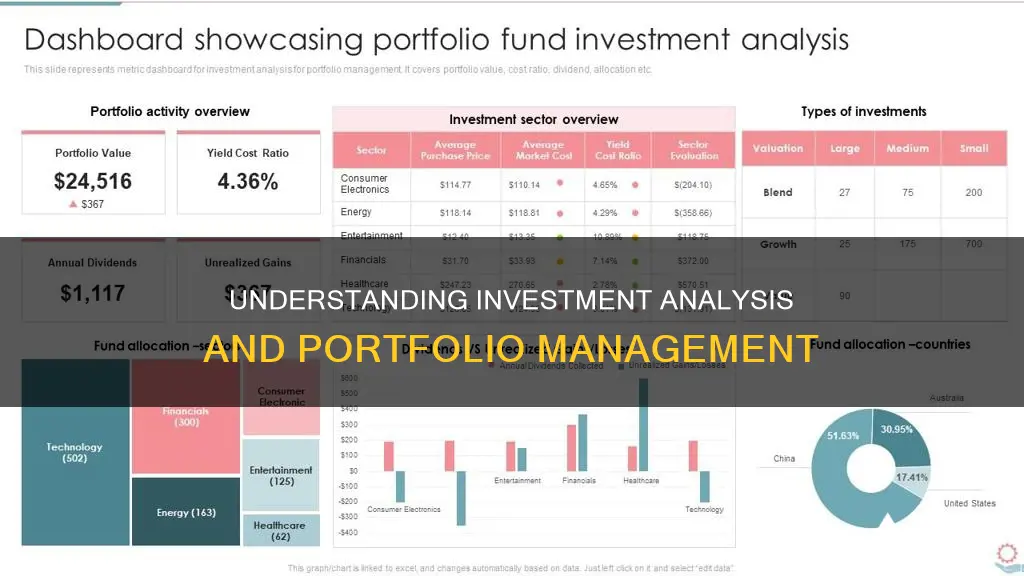
Investment analysis and portfolio management are crucial aspects of financial planning and decision-making. Investment analysis involves evaluating various investment opportunities, such as stocks, bonds, industry sectors, and economic trends, to make informed choices. It helps predict future performance and determine the suitability of an investment for a specific investor's needs and risk tolerance. On the other hand, portfolio management entails selecting and overseeing a group of investments that align with an investor's financial objectives and risk appetite. This includes understanding key elements like asset allocation, diversification, and rebalancing. Together, investment analysis and portfolio management provide a comprehensive framework for individuals and institutions to effectively manage their financial investments and make strategic decisions to meet their long-term goals.
| Characteristics | Values |
|---|---|
| Definition | A broad term for many different methods of evaluating investments, industry sectors, and economic trends. |
| Purpose | To determine how an investment is likely to perform and how suitable it is for a particular investor. |
| Types | Bottom-up, top-down, fundamental, and technical. |
| Key Factors | Appropriate entry price, expected time horizon, and role in the portfolio as a whole. |
| Importance | Key to a sound portfolio management strategy. |
| Portfolio Management | Selecting and overseeing a group of investments that meet the long-term financial objectives and risk tolerance of a client, company, or institution. |
What You'll Learn

Investment analysis methods
Investment analysis is a broad term for the many methods used to evaluate investments, industry sectors, and economic trends. It is a key part of portfolio management.
There are several types of investment analysis methods, including bottom-up, top-down, fundamental, and technical.
Bottom-Up vs Top-Down
Bottom-up investment analysis involves analyzing individual stocks for their merits, such as their valuation, management competence, pricing power, and other unique characteristics. It takes a microeconomic approach, focusing on individual companies and stocks rather than overarching trends.
On the other hand, top-down investment analysis starts with an analysis of economic, market, and industry trends, before narrowing down to specific investments that will benefit from those trends. This approach is more focused on the macroeconomic or global outlook.
Fundamental vs Technical
Fundamental analysis emphasizes the financial health of companies and the broader economic outlook. Practitioners of this method seek out stocks they believe are undervalued by the market and trading at a price lower than their intrinsic value. They evaluate a company's financial soundness, future business prospects, and dividend potential to determine if it is a worthwhile investment.
Technical analysis, on the other hand, focuses on patterns of stock prices and statistical parameters. Technical analysts use computer-generated charts and graphs to evaluate a security's strength or weakness, looking at price movements, trading signals, and other analytical tools. This method is often used by day traders to devise strategies and time their buying and selling.
Other Methods
There are other methods of investment analysis, such as capital investment analysis, which involves using cash flow and discount rate methods to conduct financial analyses. Additionally, modern portfolio theory is a common approach to portfolio optimization, helping to select the best portfolio given an investor's constraints and objectives.
Demand-Supply Equilibrium: Savings, Investments Balance
You may want to see also

Portfolio management
Active vs Passive Portfolio Management
Active portfolio management involves strategically buying and selling stocks and other assets to outperform the broader market's performance. On the other hand, passive portfolio management aims to match the market's returns by replicating the makeup of an index or indexes. Passive management is often a long-term strategy involving investing in exchange-traded funds (ETFs).
Key Elements of Portfolio Management
The key to effective portfolio management is the long-term mix of assets. This typically includes stocks, bonds, and cash equivalents such as certificates of deposit. Other alternative investments may include real estate, commodities, derivatives, and cryptocurrency.
Asset Allocation
Asset allocation is the process of distributing assets within a portfolio to achieve a preferred risk-return profile. It is based on the understanding that different types of assets do not move in concert, and some are more volatile than others. Conservative investors often have a higher allocation of bonds, while aggressive investors seek more exposure to volatile investments, such as growth stocks.
Diversification
Diversification involves spreading the risk and reward of individual securities within an asset class or between asset classes. It aims to capture returns from different sectors over time while reducing volatility. Real diversification is achieved across various classes of securities, sectors of the economy, and geographical regions.
Rebalancing
Rebalancing returns a portfolio to its original target allocation at regular intervals, usually annually. This is done to maintain the desired risk-return profile and reinstate the original asset mix after market movements have altered it. For example, a portfolio with a 70% equity and 30% fixed-income allocation may shift to an 80/20 allocation after an extended market rally. Rebalancing involves selling high-priced securities and investing in lower-priced, out-of-favour securities to capture gains and expand growth prospects while realigning with the original risk-return profile.
Challenges of Portfolio Management
Tools Used in Portfolio Analysis
Several tools and ratios are used in portfolio analysis, including Holding Period Return, Arithmetic Mean, Sharpe Ratio, Alpha, Tracking Error, Information Ratio, and Sortino Ratio. These tools help evaluate and assess the performance, risks, and potential returns of a portfolio.
Building an Investment Portfolio: Teaching Kids About Money
You may want to see also

Risk management
There are several risk management strategies that can be employed, including:
- Avoidance: This strategy involves steering clear of volatile investments and opting for safer options with minimal risks.
- Retention: Accepting risks as a trade-off for the potential of higher returns.
- Sharing: Spreading the risk among multiple parties, such as through insurance or reinsurance agreements.
- Transferring: Shifting the risk to another party, as seen with health insurance, where individuals transfer the risk of medical expenses to insurance providers.
- Loss prevention and reduction: Balancing volatile investments with more conservative choices to mitigate overall risk.
Additionally, risk management involves quantifying and measuring risk to make informed decisions. A commonly used metric is standard deviation, which measures the dispersion of returns around an expected outcome. This helps determine the level of risk an investor is comfortable accepting based on their financial situation and goals.
In the context of portfolio management, risk management is crucial for both individual and institutional investors. It helps them understand their risk tolerance, which guides their investment choices and strategies. For instance, conservative investors typically favour stable investments like bonds, while aggressive investors are more inclined to take on the higher risk of growth stocks.
Furthermore, portfolio managers employ various techniques to manage risk, including diversification, asset allocation, and rebalancing. Diversification spreads risk across different investments and sectors, reducing the potential impact of any single negative event. Asset allocation involves allocating investments across various asset classes, such as stocks, bonds, and alternative investments, to balance risk and return. Lastly, rebalancing ensures the portfolio aligns with the investor's original risk-return profile by periodically adjusting the mix of investments.
Overall, risk management is an integral part of investment analysis and portfolio management, helping investors and portfolio managers make informed decisions, protect their investments, and strive for their financial objectives while managing potential downsides.
Invest or Save? Where Should Your Money Go?
You may want to see also

Financial portfolio types
Investment analysis and portfolio management is a growing field in finance. It involves selecting and overseeing a group of investments that meet the long-term financial objectives and risk tolerance of a client, company, or institution.
Aggressive Portfolio
An aggressive portfolio seeks outsized gains and accepts the large risks that come with them. Stocks in this type of portfolio have a high beta, meaning they are very sensitive to the overall market and experience greater fluctuations in price. Aggressive investors seek out companies in the early stages of their growth that have a unique value proposition.
Defensive Portfolio
Defensive stocks do not usually carry a high beta and are relatively isolated from broad market movements. They tend to focus on consumer staples that are essential in everyday life and impervious to economic downturns. Defensive stocks do well in both good and bad economic times.
Income Portfolio
An income portfolio focuses on investments that generate income through dividends or other types of distributions to stakeholders. Some stocks in this portfolio may also fit a defensive portfolio but are primarily selected for their high yields. Income portfolios should generate positive cash flow. Examples of income-producing investments include real estate investment trusts (REITs) and master limited partnerships (MLP).
Speculative Portfolio
A speculative portfolio is the closest to gambling among these options. It involves taking on more risk than the other types. Speculative plays could include initial public offerings (IPOs) or stocks that are rumoured to be takeover targets. Technology or healthcare firms in the process of developing a single breakthrough product would fall into this category.
Hybrid Portfolio
Building a hybrid portfolio requires venturing into other investments such as bonds, commodities, real estate, and even art. This type of portfolio would traditionally include blue-chip stocks and high-grade government or corporate bonds, with fixed proportions of stocks and bonds. This approach offers diversification across multiple asset classes, which is beneficial as equities and fixed-income securities tend to have a negative correlation.
Understanding Aaron's Portfolio: Equal Investment, Beta Calculation
You may want to see also

Portfolio analysis
The process of portfolio analysis can be broken down into three main steps:
- Understanding Investor Expectations and Market Characteristics: This initial step involves aligning the expectations of the investor with the market conditions. By synchronising the investor's risk tolerance, return objectives, and market factors, there is a greater likelihood of achieving the portfolio's objectives.
- Defining an Asset Allocation and Deployment Strategy: This step involves determining the types of assets to be included in the portfolio, the analytical tools to be used, the choice of benchmark for comparison, and the frequency of performance measurement.
- Evaluating Performance and Making Necessary Changes: After a defined period, the portfolio's performance is assessed to determine if it has met its stated objectives. Any changes in investor objectives are also incorporated, ensuring that the analysis remains up-to-date and aligned with the investor's expectations.
The tools used in portfolio analysis include various ratios such as the Holding Period Return, Arithmetic Mean, Sharpe Ratio, Alpha, Tracking Error, Information Ratio, and Sortino Ratio. These ratios help calculate and compare the overall return, average returns, and risk-adjusted performance of the portfolio.
By regularly conducting portfolio analysis, investors can gain valuable insights into the performance and risks associated with their investments. This enables them to make informed decisions, adjust their investment strategies, and ultimately improve their chances of achieving their financial goals.
Partnership Investment Strategies: Portfolios Over $10 Million
You may want to see also
Frequently asked questions
Investment analysis is a broad term for the many different methods used to evaluate investments, industry sectors, and economic trends. It can include charting past returns to predict future performance, selecting the type of investment that best suits an investor's needs, or evaluating individual securities such as stocks and bonds to determine their risks, yield potential, or price movements.
Portfolio management involves selecting and overseeing a group of investments that meet the long-term financial objectives and risk tolerance of a client, company, or institution. It requires an in-depth understanding of key elements such as asset allocation, diversification, and rebalancing.
There are several types of investment analysis, including bottom-up, top-down, fundamental, and technical. Bottom-up analysis focuses on individual stocks, while top-down analysis looks at economic and market trends first. Fundamental analysis stresses the financial health of companies and the broader economic outlook, while technical analysis focuses on patterns of stock prices and statistical parameters.







